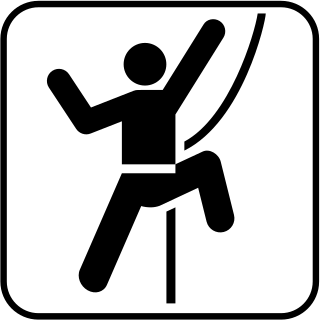
Climbing is the activity of using one's hands, feet, or any other part of the body to ascend a steep topographical object. It is done for locomotion, recreation and competition, and within trades that rely on ascension; such as emergency rescue and military operations. It is done indoors and out, on natural and man-made structures.

Mountaineering, or alpinism, is the set of outdoor activities that involves ascending tall mountains. Mountaineering-related activities include traditional outdoor climbing, skiing and traversing via ferratas. Indoor climbing, sport climbing and bouldering are also considered variants of mountaineering by some.

In rock climbing, mountaineering, and other climbing disciplines, climbers give a grade to a climbing route or boulder problem, intended to describe concisely the difficulty and danger of climbing it. Different types of climbing each have their own grading systems, and many nationalities developed their own, distinctive grading systems.
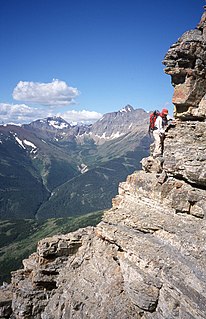
Scrambling is "a walk up steep terrain involving the use of one's hands". It is an ambiguous term that lies somewhere between hiking, hillwalking, and easy mountaineering and rock climbing. Sure-footedness and a head for heights are essential. Canyoning, Gill and stream scrambling are other types of scrambling. Gill scrambling in the UK is a type of scrambling where the base rule "is to take the hardest route and the one closest to the water, straying from the streambed only when the direct way is impassable".

Traditional climbing, is a style of rock climbing in which the climber places all the necessary protection gear required to arrest any falls as they are climbing, and then removes it when the pitch is complete. Traditional bolted aid climbing means the bolts were placed while on lead and/or with hand drills. Traditional climbing carries a higher level of risk than bolted sport climbing, as the climber may not have placed the safety equipment correctly while trying to ascend the route; for some of the world's hardest climbs, there may not be sufficient cracks or features in the rock that can accept protection gear, and the climb can only be safely attempted by bolting as a sport climb.
The Yosemite Decimal System (YDS) is a three-part system used for rating the difficulty of walks, hikes, and climbs, primarily used by mountaineers in the United States and Canada. It was first devised by members of the Sierra Club in Southern California in the 1950s as a refinement of earlier systems, particularly those developed in Yosemite Valley, and quickly spread throughout North America.

This glossary of climbing terms is a list of definitions of terms and jargon related to rock climbing and mountaineering. The specific terms used can vary considerably between different English-speaking countries; many of the phrases described here are particular to the United States and the United Kingdom.

Free climbing is a form of rock climbing in which the climber may use climbing equipment such as ropes and other means of climbing protection, but only to protect against injury during falls and not to assist progress. The climber makes progress by using physical ability to move over the rock via handholds and footholds. Free climbing more specifically may include traditional climbing, sport climbing, bouldering and most forms of solo climbing. Free climbing a multi-pitch route means free-climbing each of its pitches in a single session. At the end of each pitch, climbers anchor themselves to belay stations where they can rest.
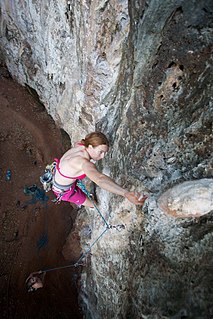
Sport climbing, is a form of rock climbing that relies on permanent anchors, permanently fixed into the rock for climber protection, in which a rope that is attached to the climber is clipped into the anchors to arrest a fall; it can also involve climbing short distances with a crash pad underneath as protection. This is in contrast to traditional climbing where climbers must place removable protection as they climb. Sport climbing usually involves lead climbing and toproping techniques, but free solo and deep-water solo climbing on sport routes is also sometimes possible.

Belaying is a variety of techniques climbers use to create friction within a climbing system, particularly on a climbing rope, so that a falling climber does not fall very far. A climbing partner typically applies tension at the other end of the rope whenever the climber is not moving, and removes the tension from the rope whenever the climber needs more rope to continue climbing.

Lead climbing is a climbing style, predominantly used in rock climbing. In a roped party one climber has to take the lead while the other climbers follow. The lead climber wears a harness attached to a climbing rope, which in turn is connected to the other climbers below the lead climber. While ascending the route, the lead climber periodically connects the rope to protection equipment for safety in the event of a fall. This protection can consist of permanent bolts, to which the climber clips quickdraws, or removable protection such as nuts and cams. One of the climbers below the lead climber acts as a belayer. The belayer gives out rope while the lead climber ascends and also stops the rope when the lead climber falls or wants to rest.

Rock climbing is a sport in which participants climb up, down or across natural rock formations or artificial rock walls. The goal is to reach the summit of a formation or the endpoint of a usually pre-defined route without falling. Rock climbing is a physically and mentally demanding sport, one that often tests a climber's strength, endurance, agility and balance along with mental control. Knowledge of proper climbing techniques and the use of specialized climbing equipment is crucial for the safe completion of routes.

A dynamic rope is a specially constructed, somewhat elastic rope used primarily in rock climbing, ice climbing, and mountaineering. This elasticity, or stretch, is the property that makes the rope dynamic—in contrast to a static rope that has only slight elongation under load. Greater elasticity allows a dynamic rope to more slowly absorb the energy of a sudden load, such from arresting a climber's fall, by reducing the peak force on the rope and thus the probability of the rope's catastrophic failure. A kernmantle rope is the most common type of dynamic rope now used. Since 1945, nylon has, because of its superior durability and strength, replaced all natural materials in climbing rope.

Slab climbing is a type of rock climbing where the rock face is at an angle less steep than vertical. It is characterized by balance- and friction-dependent moves on very small holds. It is often not leadable, or climbable from the ground up, unless it has pre-drilled bolts to protect the climb, making most slab climbs either top rope climbing or sport climbing. Special techniques such as smearing are necessary to climb slab. It is a type of face climbing and is distinctly different from crack climbing. Slab climbing is a relatively new area of climbing, having become more popular in the last 30 years, and some of the highest graded routes are currently being realized.

To have a head for heights means that one has no acrophobia, an irrational fear of heights, and is not particularly prone to fear of falling or suffering from vertigo, the spinning sensation that can be triggered, for example, by looking down from a high place.
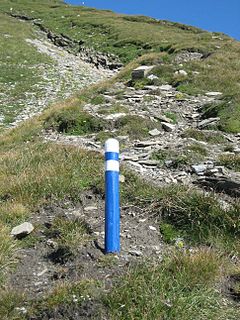
An alpine route is a trail or climbing route through difficult terrain in high mountains such as the Alps, sometimes with no obvious path. In the Alps, the Alpine clubs define and mark an alpine route, also called alpinweg or alpinwanderweg.
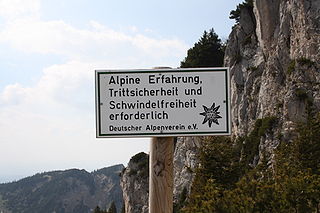
Sure-footedness refers to the ability, especially when hiking or mountain climbing, to negotiate difficult or rough terrain safely. Such situations place demands on a person's coordination and reserves of strength as well as requiring sufficient appreciation of the terrain. A person who is sure-footed is thus unlikely to slip or stumble.
The term rope team, roped team or roped party, originally came from mountain sports, especially climbing, where it describes a group of people joined by a mountain or climbing rope and thus secured against falling.

Alpine climbing is a branch of climbing in which the primary aim is very often to reach the summit of a mountain. In order to do this high rock faces or pinnacles requiring several lengths of climbing rope must be ascended. Often mobile, intermediate climbing protection has to be used in addition to the pitons usually in place on the climbing routes.
















